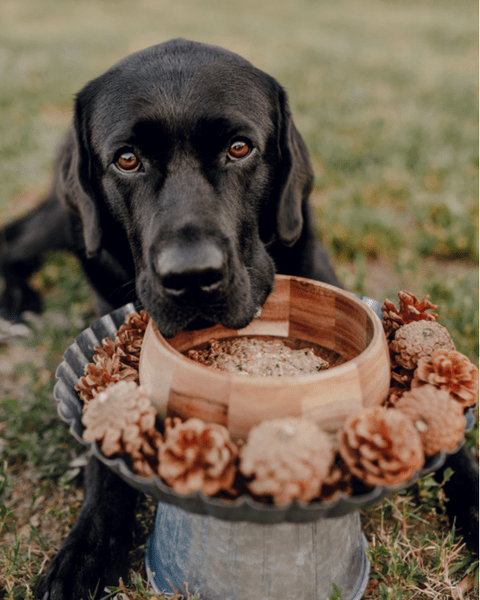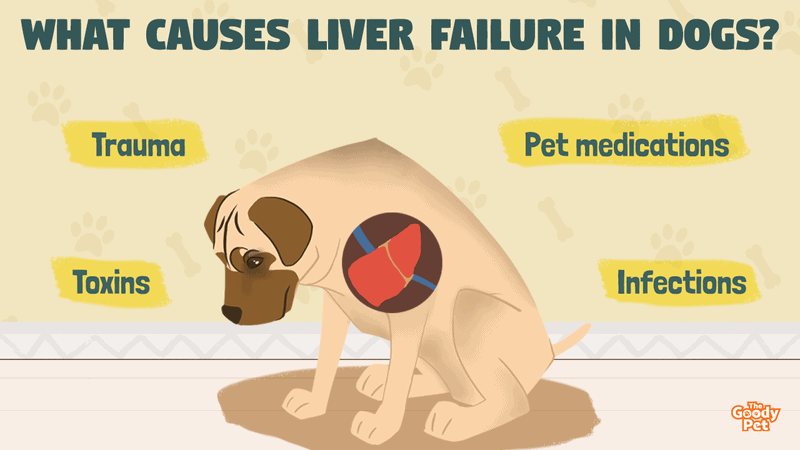The liver of a dog, like that of all animals, is a vital organ that performs essential functions for survival. Toxins in the blood are removed by the liver and sent out as part of several biological processes.
We completely understand your concern if you fear your dog is suffering from liver disease. Your dog’s life is more important than everything else to you as a pet parent. Early detection will help ensure that your pet lives a happy, healthy life.
The major causes of liver diseases are thought to be highly curable but the unpleasant reality is that there are a great variety of causes for liver disease in dogs, some of which are still unknown. The following are the most common causes of liver disease in dogs:
- Infections
- Trauma
- Pet medications
- Diet
- Toxins
The objective is to keep an eye out for early warning signals, as many dogs with liver disease may not show any clinical signs at all, and to follow your veterinarian’s advice. Continue reading to learn how to be a liver-aware fur parent.
What Food Can Cause Liver Failure In Dogs?

The liver of your dog can be harmed by consuming processed food. The common food additive, Xylitol, is often used to sweeten candy, toothpaste, gum, baked goods, and some diet meals, but it is responsible for damaging your doggie’s liver. How this happens is due to a drop in your canine pet’s blood sugar and liver failure.
If you have been feeding your pooch all the food that has been mentioned above, keep on reading this section to know more about what to feed your doggie who has liver disease.
Is Peanut Butter Okay For Dogs With Liver Disease?
Peanut butter should not be eaten by dogs that suffer from liver diseases. This is because peanut butter contains sugar, which can be harmful to your pooch with liver disease. Peanut butter’s fat content raises the risk of pancreatitis, which can kill your canine pet if their livers are already weak.
How Can I Naturally Lower My Dog’s Liver Enzymes?
Feed your pooch leaner cuts of meat. Avoid fatty meats like buffalo, duck, bison, and cattle, as well as meat rendered from slaughterhouses. We also advise staying away from kibble or canned food. Additionally, stop feeding your doggie huge marrow bones as it contains a lot of fat.
Cheap treats, regardless of whether they are natural, should be avoided. If it’s too inexpensive, it’s probably because the ingredients are as well. Because of China’s history of defective food and excessive usage of additives and preservatives, avoid any food prepared there.
How To Feed A Dog Who Has Liver Disease?
Because the causes of liver disease in dogs differ, so do the treatments for this condition. It’s important to work up a strategy with your veterinarian depending on the causes of your furry pet’s liver disease, but dietary adjustments can surely help.
Any dietary adjustments you make should be done gradually. It can damage your canine buddy’s stomach and make them feel worse than ever if you do it too quickly. Rather than just 1 or 2 two meals per day, try to feed your pooch multiple times throughout the day.
To make it easy on your dog’s stomach and reduce the quantity of nutrition the liver needs to digest, stick to smaller meals and feed your dog 4 to 5 times per day.
What Causes Sudden Liver Failure In Dogs?

Sudden liver failure, also known as acute liver failure, is identified by the loss of 70% or more of the liver’s function as a result of quick, severe hepatic necrosis. The most common causes of sudden liver failure are listed below:
- Toxins
- Drugs or chemicals
- Inability to breathe
- Excess exposure to heat
Your dog has the possibility to die if this disease is not addressed quickly. Continue reading this section to discover more about how to improve your dog’s liver function.
How Can I Improve My Dog’s Liver Function?
Use appropriate nutrition to keep your furry pet’s liver healthy or to help them recover from a liver imbalance. Feeding your pooch fatty, difficult-to-digest dry meals is not a good idea. In general, doctors recommend feeding a low-fat, low-protein diet to a dog who is suffering from liver disease.
Examples of readily digestible meals that nourish the liver and blood are as follows:
How Long Can My Dog Live After Having A Liver Disease?
A dog suffering from liver disease is expected to live for a few months or even years. The length of your canine pet’s life is usually dictated by the cause of their liver failure, how far along it is once discovered, and the treatments accessible to your pooch.
If your doggie’s liver disease has been detected early and is being continuously managed, it can live for a long time. Liver disease in dogs normally worsens over time, so symptoms may not appear for several years. Liver disease can be fatal to dogs if not treated in time.
Are Dogs With Liver Disease Feel A Lot Of Pain?
The inflammation, which is the earliest stage of your dog’s liver disease, may be felt or visible on a radiograph, but it is rarely painful for your dog. At this time, liver disease is frequently treatable with medicine as well as a change in diet.
Dogs with chronic liver disease, on the other hand, tend to retain fluids and develop abdominal swelling. If the liver is inflamed, it might cause pain in the abdomen.
Which Dog Breeds Are Prone To Liver Disease?
It’s not unusual to see a dog suffering from liver disease, but some dog breeds may be more susceptible than others. The following is a list of dog breeds that are thought to be prone to liver disease:
- Samoyed
- Cairn Terrier
- Labrador Retriever
- Doberman Pinscher
- Great Dane
- Dalmatian
- English Cocker Spaniel
- Crossbreeds
Puppies can also be born with a hepatic shunt, which is a hereditary disorder that disrupts blood circulation in the liver.
What Are The Types Of Liver Conditions In Dogs?
Acute and chronic liver diseases are the two types of liver diseases. The acute liver disease strikes immediately and necessitates medical attention right away. Chronic liver disease develops over time and can be brought on by a chronic illness such as cancer or diabetes.

How Do You Prevent Liver Failure In Dogs?
The first step is to get toxins out of your canine pet’s body. This includes avoiding unneeded immunizations, insecticides, chemicals, and medications in favor of natural alternatives.
The second step is to eliminate all harmful food from your dog’s diet. You’re feeding your pooch toxins if you feed him processed food. Toxic byproducts such as acrylamides and heterocyclic amines can be found in processed meals. These put your dog’s liver under even more strain.
The third option is to include milk thistle in your dog’s diet. Milk thistle helps liver cells repair by protecting them from toxins and damage. If your canine pet already has liver disease, milk thistle can aid with immediate support.
What To Do If Your Dog Has Liver Disease?
If your dog has already been diagnosed with liver disease by your trusted vet, you should follow their advice.
Most canines will be able to treat the condition with just a change in diet; others will require extra medications and medical attention. In any case, your pooch will benefit from a special diet to help with their liver issues.
We understand that you’re afraid of losing your dog but having a positive mindset may help your dog battle through this disease.
Can My Dog Still Recover From Liver Disease?
Early detection of the disease can save your dog’s life. It is possible for your dog to recover completely from liver disease, but this is uncommon and only occurs when only a tiny portion of the liver is damaged.
Once your dog’s liver condition is healed, they can already stop taking their meds and consume typical maintenance food. However, it is entirely dependent on the particular diagnosis. Chronic liver disease in dogs necessitates a therapeutic diet as well as a long-term prescription of liver-support medicines.

How Do I Know If My Dog Is Already Dying From Liver Disease?
Liver disease in dogs is divided into phases based on the range of symptoms and the extent of damage to your canine pet’s liver. The final stage of liver disease occurs when the liver has been nearly completely consumed by dead tissue.
You’ll need to be mentally prepared and come to terms with your pooch facing end-stage liver disease, as death will ensue. The following are some of the signs and symptoms of end-stage liver disease in dogs:
- Bleeding
- Seizures
- Vomiting
- Swollen abdomen
- Diarrhea
- Jaundice
- Loss of consciousness
- Lethargy





